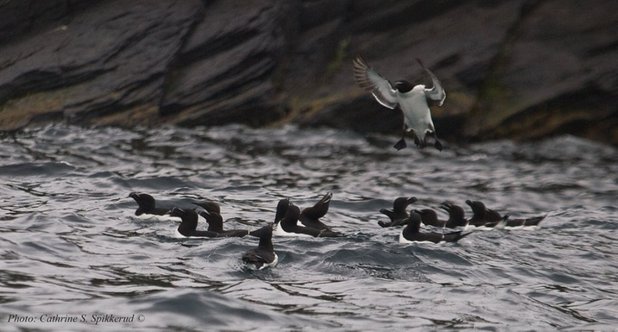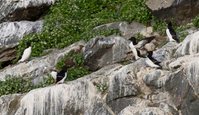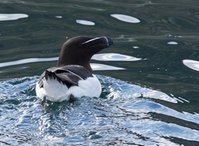Razorbill (Alke)
Razorbills forage in coastal and open sea waters and breed in cliffs on the coast. They do not gather in large colonies like puffins and guillemots. They are highly vulnerable to surface and shoreline oil.

Vulnerability towards oil
Razorbills spend the greater part of the time on the water surface. Gathering of large flocks may lead to high mortalities.
Seaward
- May be oiled when swimming on the surface and diving for fish.
- Foraging range is small in the breeding season.
- Oiled plumage will cause the bird to lose flotation and insulation
- No avoidance of oil slicks.
- Foraging zone is close to the coast in the breeding season.
Landward
- Breeding season: May-July.
- Razorbills nest in cracks or in hollows in rocky cliffs, usually too high up to be vulnerable to shoreline oiling.
- Are less typical colony breeders than the guillemots and puffins, and can be found breeding along side these species, and with kittiwake
Typical environmental zone
- Razorbill breeding sites are generally found in the outer coastal zone where they breed in steep cliffs.
- Breeding sites are found close to rich fishing banks and shallow waters, main prey is fish.
- Foraging range in the breeding season is close to the coast, some places very close (2-15 km).
- Outside the breeding season razorbills may be found in large flocks of several alcid (auk) species in the open sea far from the coast. These flocks gather at eddies with high production and presence of fish prey.
Protection/oil spill combat
- Special issues:
- Colonies of auks usually have a high protection status
- Barrier 3 and 4: Upstream protection of the colony by mechanical recovery of oil expected to drift in the direction of sea bird colonies
- Upstream chemical dispersal of oil slicks should be considered if mechanical containment and recovery is not possible.
- Barrier 5, shoreline cleanup should be prioritised on and surrounding the cliffs where sea birds rest. Cliffs can be cleaned by hosing the oil with water. Protect the surrounding areas from remobilised oil by fencing off with booms and using skimmers to collect oil.
Oiled birds
- Dead birds should be collected for post-spill environmental surveys, which involves identification of the species. Handle only with protective equipment and store according to procedure for collecting
- If operator policy requires, oiled live birds should be collected by specialists in wildlife rehabilitation for treatment. Specialists and veterinaries trained in rehabilitation will decide whether to euthanise or rehabilitate the animal.


